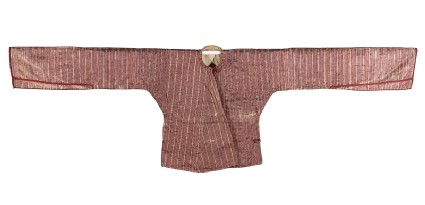Browse: 153 objects
- Reference URL
Actions
Striped mashru jacket
-
Description
Edward William Lane (1801-1876) lived in Cairo for several years. He immersed himself in Egyptian society: he adopted local dress, rented a house in the Arab Quarter, and developed a wide circle of Egyptian friends. Trained as an engraver, he recorded his observations in sketches and drawings, and he kept diaries and notebooks. When he returned to England he became a renowned Arabic scholar.
The Ashmolean has a set of Turkish-style clothing worn by Lane during his time in Cairo, donated by his direct descendant Catherine Dupré. This jacket is sewn in Turkish style, with cross over fastenings and pink silk braid. The mixture of silk and cotton is called mashru.
-
Details
- Associated place
-
The Ancient Egyptian World › Lower Egypt › Alexandria (possible place of purchase)
- Date
- 1825 - 1835
- Material and technique
- coloured silk and cotton (mashru); pink silk braid; cotton lining
- Dimensions
-
width at sleeve 61 x 200 cm (height x width)
width at hem 61 x 49.5 cm (height x width)
- Material index
-
organic › animal › animal product › silk,
- Technique index
-
dyed,
- Object type index
- No. of items
- 1
- Credit line
- Presented by Catherine Dupré, 1983.
- Accession no.
- EA1983.7
Location
-
- currently in research collection
Objects are sometimes moved to a different location. Our object location data is usually updated on a monthly basis. Contact the Jameel Study Centre if you are planning to visit the museum to see a particular object on display, or would like to arrange an appointment to see an object in our reserve collections.
Galleries
© 2013 University of Oxford - Ashmolean Museum



